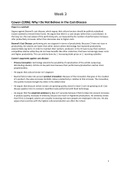Week 3
Cowen (1996): Why I Do Not Believe in the Cost-Disease
Paper in a nutshell
Argues against Baumol’s cost disease, which argues that cultural sectors should be publicly subsidised.
Cowen wanted to remove these funds. He argues that there is a cost-utopia rather than a cost-disease. In
the long run, the real output of the performing arts, as measured by the number of performance increases,
infer produc vity increases rather than decreases due to higher costs.
Baumol’s Cost Disease: performing arts are stagnant in terms of produc vity. Because CI have not risen in
produc vity, the salaries are lower than other sectors where technology has improved produc vity
exponen ally (eg tech). In order to maintain their workers, producers in the CI have to pay their workers
compe ve salaries while they do not have bene ts like other industries, that have increasingly lower costs
and higher produc vity. This can only be done by 1. Increasing cket prices or 2. receiving subsidies
Cowen’s arguments against cost disease:
- Process innova on: technology extends the possibility of reproduc on of the ar s c output (eg
distribu ng ebooks). Ar sts can be paid more because their performance/produc on reaches more
people/outlets.
- He argues that cultural sector isn’t stagnant
- Baumol fails to take into account product innova on. Because of the innova on that goes in the crea on
of a product, the value increases tenfolds- labour produc vity is rela ve to that increase. The innova on,
the quality increase brought by ar sts is the added value
- He argues that because certain sectors are growing quickly, doesn’t mean CI are not growing at all. Cost
disease applies more to constant, repe ve tasks performed with xed technology.
- He argues that the empirical evidence by Bau isn’t accurate because it fails to take into account increases
in product quality, increases in diversity, focuses too much on highbrow produc ons. His evidence shows
that if this is changed, salaries are actually increasing and more people are employed in the arts. He also
argues that countries with the highest cultural produc on are o en the richest.
1
titi
tititi ti ti ti ti ti titi tifi ti ti tift fititi ti ti titititi ti titi
, Dunham, Freeman (2000) There is Business Like Show Business:
Leadership Lessons from the Theatre
Paper in a nutshell
Business leaders can gain new insights in new leadership requirements by examining the arts, namely best
in class theatre directors. Theatre directors are able to manage human complexity.
Principle of Unity and Mul plicity: (1)achieving organisa onal unity and cohesiveness behind a vision or set
of goals, whereas at the same me (2) giving free rein to the mul ple, individual and unique talents of the
people within their organisa ons. They argue this mastering of cohesion from fragmented individual ac vity
will be fundamental in future organisa ons ‘leadership.
Arguments in favour of this understanding
Business leader and theatre director have similar roles to ar culate a vision and develop a strategy, leading
the company. Par cularly, theatre directors are able to ar culate a unifying vision that pulls together
separate talents and skills
Lessons from the theatre directors
1. Use the right type of informa on. Do not limit to quan ta ve as qualita ve informa on allows a
broader understanding of human features and individuality. Complement abstract informa on with
par cular info of every individual at play.
This enables them to Draw vision from the par cular, focusing on the par cular and intensively
personal, seeking a deeper and richer understanding of the human nature, to enable the intui ve leap
from knowledge to visions.
2. Emphasise good cas ng- nd the right players; Balancing an understanding of the demands of the role
with a respect for the unique quali es the actor brings to it; Avoiding typecas ng. Find people that t
the role while being able to work in the team e ec vely
3. Approach the work collabora vely- to ensure this: Create the “sca olding” within which actors freely
perform their cra , Address fear, Encourage experimenta on and failure, and keep the scale small. By
fostering collabora on the business director moves from mul plicity to unity.
4. Embrace complexity-favour prisma c rather than simplis c thinking processes: explore problems in all
complicated dimensions and accept mul ple points or answers. Create and consider mul ple and
contradictory scenarios. Open minded approach to problem solving
5. A une to the environment rather than adherence to systemisa on- stay agile, avoid automa c,
rou ne responses. Keep an eye on the process as well as the outcome-how did we get here?
Human judgement over predic on, automa on, and systemisa on.
6. Manage tension between learning and crea vity-con nue learning without falling into habit, protect
crea vity by approaching each problems as novice.
Encourage be er listening, authen c response to the situa on, trust employees in abili es to take
risks, keep an open mind to depar ng from ini al vision.
Note: Nachoem cri ques consultancy style, no empirical evidence- also they completely focus on the ar s c
director. They ignore the business director, while most businesses have this type of dual leadership- Dual
leadership connec on?
2
tt titi
tt fttititi ti fiti tititititi tititi ti ti ti tiffti ti ti tititititi ti tititi ff ti ti ti ti ti titi ti fi titi ti





